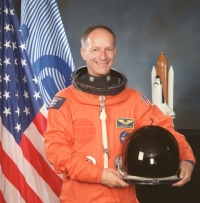Claude Nicollier
From The Space Library
 Claude Nicollier | |
| Birth Name | Claude Nicollier |
|---|---|
| Birth Date | Sept 2 1944 |
| Occupation | Astronaut, European Space Agency |
Contents |
[edit] Personal Data
Born September 2, 1944, in Vevey, Switzerland. His wife, the former Susana Perez of Monterrey, Mexico, died in December 2007. He has two daughters, Maya and Marina, and one grandchild. He enjoys mountain climbing, flying, and photography. His father, Mr. Georges Nicollier, resides in La Tour de Peilz, Switzerland.
[edit] Education
Graduated from Gymnase de Lausanne (high school), Lausanne, Switzerland, in 1962; received a bachelor of science in physics from the University of Lausanne in 1970 and a master of science degree in astrophysics from the University of Geneva in 1975. Also graduated as a Swiss Air Force pilot in 1966, an airline pilot in 1974, and a test pilot in 1988 (Empire Test Pilots School, Boscombe Down, United Kingdom).
[edit] Experience
From 1970 to 1973, Claude worked as a graduate scientist with the Institute of Astronomy at Lausanne University and at the Geneva Observatory. He then joined the Swiss Air Transport School in Zurich and was assigned as a DC-9 pilot for Swissair, concurrently participating part-time in research activities of the Geneva Observatory. At the end of 1976 he accepted a Fellowship at the European Space Agencys (ESA) Space Science Department at Noordwijk, Netherlands, where he worked as a research scientist in various airborne infrared astronomy programs. In July 1978 he was selected by ESA as a member of the first group of European astronauts. Under agreement between ESA and NASA he joined the NASA astronaut candidates selected in May 1980 for astronaut training as a mission specialist. His technical assignments in the Astronaut Office have included flight software verification in the Shuttle Avionics Integration Laboratory (SAIL), participation in the development of retrieval techniques for the Tethered Satellite System (TSS), Remote Manipulator System (RMS), and International Space Station (ISS) robotics support. From the Spring of 1996 to the end of 1998, he was Head of the Astronaut Office Robotics Branch. From 2000-2007, he was assigned to the Astronaut Office EVA (Extravehicular Activity) Branch, while maintaining a position as Lead ESA astronaut in Houston. He retired from ESA in March 2007 and plans to teach an Introduction to Aerospace course at the Federal Institute of Technology in Lausanne, Switzerland. Claude holds a commission as captain in the Swiss Air Force. He has logged 7,062 hours flying time--including 4,000 hours in jet aircraft.
[edit] Spaceflight Experience
NASA/ESA EXPERIENCE: A veteran of four space flights, Claude has logged more than 1,000 hours in space including 1 space walk totaling 8 hours and 10 minutes. He served on STS-46 in 1992, STS-61 in 1993, STS-75 in 1996, and STS-103 in 1999. SPACE FLIGHT EXPERIENCE: STS-46 Atlantis (July 31-August 8, 1992), was an 8-day mission during which crew members deployed the European Retrievable Carrier (EURECA 1) science platform, and conducted the first Tethered Satellite System (TSS) test flight. Mission duration was 191 hours, 16 minutes, 7 seconds. STS-46 was launched from and returned to land at Kennedy Space Center, Florida. The mission was accomplished in 126 orbits of the Earth and traveled 3.35 million miles in 191 hours, 16 minutes and 7 seconds. STS-61 Endeavour was the first Hubble Space Telescope (HST) servicing and repair mission. STS-61 launched at night from the Kennedy Space Center, Florida, on December 2, 1993. During the 11-day flight, the HST was captured and restored to full capacity through a record five space walks by four astronauts. After having traveled 4,433,772 miles in 163 orbits of the Earth in 259 hours, 59 minutes. STS-75 Columbia (February 22 to March 9, 1996) was a 15-day flight, with principal payloads being the reflight of the Tethered Satellite System (TSS) and the third flight of the United States Microgravity Payload (USMP-3). The TSS successfully demonstrated the ability of tethers to produce electricity. The TSS experiment produced a wealth of new information on the electrodynamics of tethers and plasma physics before the tether broke at 19.7 km, just shy of the 20.7 km goal. The crew also worked around the clock performing combustion experiments and research related to USMP-3 microgravity investigations used to improve production of medicines, metal alloys, and semiconductors. The mission was completed in 252 orbits covering 6.5 million miles in 377 hours and 40 minutes. STS-103 Discovery (December 19-27, 1999) was an 8-day mission during which the crew successfully installed new instruments and upgraded systems on the Hubble Space Telescope (HST). Enhancing HST scientific capabilities required three space walks (EVA) totaling 24 hours and 33 minutes. The STS-103 mission was accomplished in 120 Earth orbits, traveling 3.2 million miles in 191 hours and 11 minutes.
[edit] Organizations
Member of the Swiss Astronomical Society, the Astronomical Society of the Pacific, the Swiss Air Force Officers Society (AVIA), and the Swiss Academy of Engineering Sciences. Fellow of the British Interplanetary Society. Honorary member of the Swiss Aero Club, and the Swiss Society of Engineers and Architects.
[edit] Special Honours
NASA Distinguished Service Medal (2001), Four NASA Space Flight Medals (1992, 1993, 1996, 1999), Prix d'honneur de la Fondation Pro Aero, Switzerland (1992), Yuri Gagarin Gold Medal from the International Aeronautical Federation (1994), Silver Medal from the Acadmie Nationale de l'Air et de l'Espace, France (1994), Collier Trophy (awarded to the crew of STS-61) from the National Aeronautics Association (1994), Prix de l'Universit de Lausanne (1994), honorary doctorates from the Swiss Federal Institute of Technology, Lausanne, and the Geneva University (both in 1994). Appointed professor at the Swiss Federal Institute of Technology, Lausanne, in November 1994.
[edit] Other Information
Dec-07
